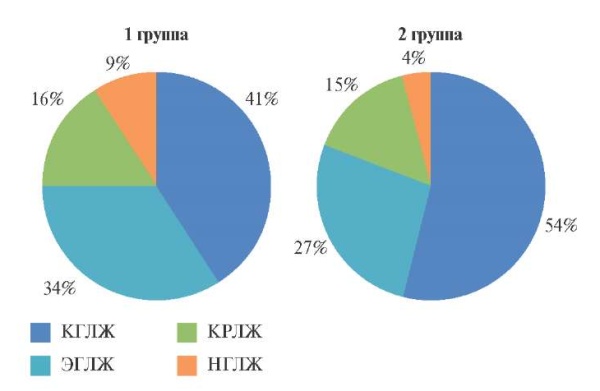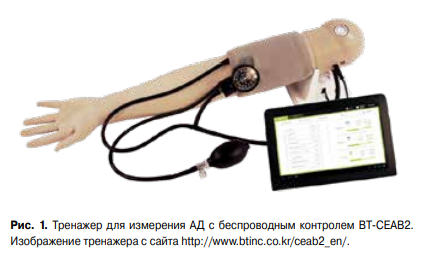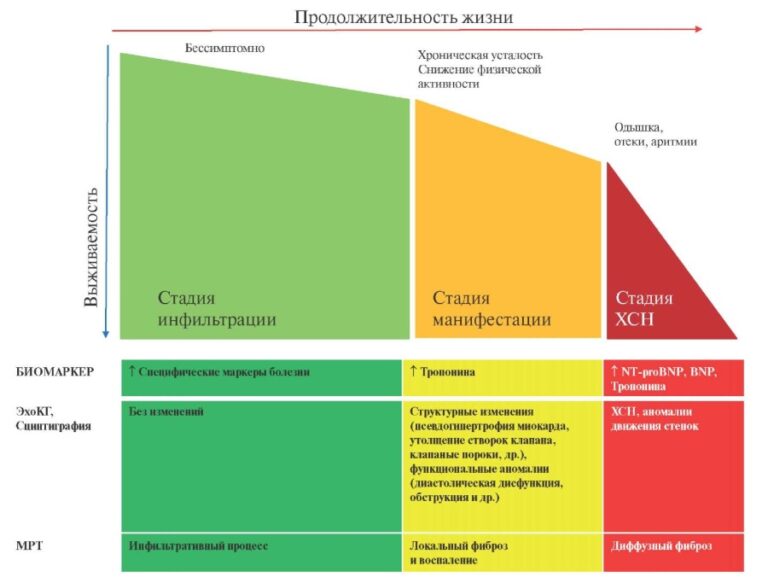Изменение концентрации биомаркеров дисфункции эндотелия при приеме ингибиторов тирозинкиназы I и II поколений у пациентов с хроническим миелолейкозом как фактор риска развития сердечно-сосудистых осложнений
Within the last decades there was progress in treatment of oncological pathology, the amount of drugs for anticarcinogenic therapy which are aimed at the alarm ways connected with cellular proliferation has increased (for example, inhibitors of tyrosinekinase (TKI)). Thanks to modern chemotherapy, the considerable results concerning duration and quality of life of patients [1] are achieved. However, modern anticarcinogenic therapy leads to serious side effects, in particular from cardiovascular system — to cardiotoxicity, which can be shown by development of arterial hypertension, disturbances of rhythm, heart failure, changes on ECG, dysfunction of left ventricle [2-5].
The chronic myeloid leukemia (CML) represents the myeloproliferative new growth caused by activation of oncogene of BCR-ABL1 [6]. Frequency of CML increases with age and by estimates in the Russian Federation is 0,7 cases on 100 people [7]. TKI are basis of treatment of CML [8]. In the first line and the subsequent therapy use imatinib, nilotinib and dasatinib; bosutinib is shown for patients with resistance or intolerance to the previous therapy of TKI. Ponatinib is used at patients with mutation of T315I or at other mutations for which there is no other therapy of TKI [9]. Significant progress in development of TKI has led to increase in life expectancy and to improvement of quality of life of patients [1]. However, an important place is given to the development of adverse events (AEs) and comorbidity during therapy.
Safety of therapy is important for sick CML at constant uses of TKI that it is connected with requirement of continuous treatment [10]. In spite of the fact that the majority of AEs initially arise at early stage of treatment, emergence of some adverse events including clinically significant cardiovascular and metabolic, it is possible months or even years later has begun therapies [11]. The median of age, sick CML in the Russian Federation makes 49 years therefore these patients can have associated diseases and risk factors which increase probability of the mediated toxicity TKI during prolonged treatment [12].
Dysfunction of endothelium to which leads oxidizing stress and inf lammation is the pathophysiological cornerstone of development of the majority of cardiovascular diseases: the permeability of vascular wall for lipoproteins changes, there is activation of molecules of adhesion of leukocytes and moving of leukocytes to arterial wall [13]. Reduction of products and/or availability of nitrogen oxide (NO) and also imbalance between the vasodilators and vasoconstrictors developed by endothelium is characteristic of development of endothelial dysfunction [14]. On model of endothelium of rats, it is shown that increase in NO, endothelin-1 (ET-1) and other inflammatory markers can be induced by hyperhomocysteinemia [15]. Homocysteine is minor product of numerous biological processes in human body and, being raised, can be connected with heavy atherosclerosis and thrombotic occlusion [16]. ET-1 is the most powerful vasoconstrictor identified today, making extremely strong reduction of number of blood vessels of mammals of in vitro, including arteries and veins of the person [17]. The vascular endothelial growth factor (VEGF) has pro-angiogenic activity and also increases permeability of vessels and is necessary in human body for forming and maintenance of endothelial permeability [18].
However, the problem of diagnostics of endothelial dysfunction as predictor of arterial hypertension at oncohematological patients remains poorly studied that is of special interest for scientists.
Purpose of the study. To reveal interrelation of endothelial dysfunction at patients with CML, the accepting TKI I and the II generations, and development of arterial hypertension.
Material and methods
Examination of 137 patients with CML in chronic phase aged from 30 till 50 years on the basis of hematology unit of clinic of Samara State Medical University, the Institute of Experimental Medicine and Biotechnologies Samara State Medical University, Almazov National medical research center of the Ministry of Health of the Russian Federation. The diagnosis of CML (ICD X C92.1 code) has been established according to the recommendations of the European Society LeukemiaNet (2013) on the basis of results of clinical laboratory researches and detection of Ph-chromosome and/or gene of BCR-ABL [19]. On the basis of the abovestated criteria also the disease phase has been established.
Inclusion Criteria:
1. Patients with Ph-positive chronic myeloid leukemia in chronic phase prior to treatment or the accepting inhibitors of tyrosinekinase of I (TKI1) imatinib and the II (TKI2) generations (dasatinib, nilotinib).
2. Existence of the informed consent of the patient to participation in research.
3. Patients aged 30 to 50 years.
Exclusion Criteria:
1. Acute disorder of cerebral circulation within 6 months before inspection.
2. The postponed myocardial infarction.
3. Existence of diabetes mellitus of I, II types.
4. Existence of chronic disease of kidneys of the I-V stage
5. Existence of coronary heart disease with its clinical manifestations (the II-IV functional class).
6. Existence of idiopathic hypertension of the III degree prior to therapy of TKI.
7. Existence of other oncological diseases.
8. Inflammatory diseases in aggravation stage.
The number of men has made — 64 (47%), women — 73 (53%). The median of age of patients has made 47 years (30-50). All patients have been divided into four groups. 39 patients accepting imatinib in dose of 400 mg/day have entered into the first group; in the second — 36 patients accepting dasatinib in dose of 100 mg/day; in the third — 38 patients accepting nilotinib in dose of 800 mg/day; in the fourth (group of control) — the patients with for the first time the revealed diagnosis of CML who have not begun to accept TKI. The median of reception of TKI has made 25±5,84 months.
At all patients the anamnesis of course of disease, its duration, duration of reception of TKI in detail became clear. For calculation of the index of body weight (BMI) growth and weight was measured. To all patients routine researches were carried out: the bulk analysis of blood (BAB) on Sysmex KX-21N hemanalyzer (Roche Diagnostics, Switzerland), the biochemical analysis of blood including research of lipidic range, markers of system inflammation — the C-reactive Protein (CRP), fibrinogen, markers of endothelial dysfunction — homocysteine, endothelin-1 (ET-1), angiogenesis marker — vascular endothelial growth factor (VEGF). Level detection of ET-1 and VEGF was made by means of enzyme immunoassay. For definition of ET-1 set (BIOMEDICA GRUPPE) for quantitative definition of human big endothelin (1-38) in blood serum, measurement range has been used: 0,02-3 pmol/L. The VEGF level was determined by set (eBioscience) for quantitative definition of human soluble receptor of 1 vascular endothelial growth factor (sVEGFR1) in serum samples by method of enzyme immunoassay.
To all patients measured the heart rate (HR). Measurement of the arterial blood pressure (ABP) was taken once by means of the auscultatory sphygmomanometer on both hands, repeated measurement of the ABP was taken in 2 minutes from previous.
The data obtained during the research processed, using the standard Microsoft Excel program and package of the certified SPSS 13.0 and Stat Soft Statistica 6.1 programs, the following mathematicalstatistical methods have been applied: KolmogorovSmirnov’s criterion for assessment of normality of distribution of values, standard descriptive statistics (average, standard error of average, median, minimum, maximum), non-parametric Mann-Whitney U-test for comparison of quantitative indices, rank correlation coefficient of Spearman’s for interrelation research between quantitative characters. Distinctions considered statistically significant at р<0,05 [20].
The research has been executed according to standards of appropriate clinical practice (Good Clinical Practice) and the principles of the Helsinki declaration. The study protocol was approved by the ethical committee of Samara State Medical University.
Results
The specified groups of patients have been inspected. It is most characteristic of the patients accepting nilotinib 800 mg/day there was periodic increase in arterial blood pressure (mainly in the morning). In detail clinical and demographic characteristics of sick CML are provided in table 1. In the relation of the gender and age characteristic it should be noted bigger number of women in each group, than men without statistically significant distinctions on age. Among patients in the groups receiving TKI statistically significant distinctions on BMI, duration of disease and reception of therapy of TKI were not observed (Table 1).
At the patients accepting imatinib 400 mg us statistically significant differences in the values of Psys and Pdias, the values of the lipid profile from the control group.
In the group of patients with CML receiving dasatinib at a dose of 100 mg/day a statistically significant increase in systolic blood pressure values was found (Psys 132,41±5,19 mm Hg, p<0,05) compared with the control group and the group of patients taking imatinib 400 mg/day.
Significant changes in the lipid profile were also detected: an increase in the level of VLDL (0,72±0,08 mmol/l, p<0,05) compared with the control group and the first group, an increase in the level of TGs (1,38±0,11 mmol/l, p<0,05) compared with the control group and AC (3,11±0,17, p<0,05) compared with the control group.
In the group of patients with CML taking nilotinib at a dose of 800 mg/day. There was a statistically significant increasing in systolic and diastolic blood pressure levels (Psys 143,21±4,78 and Pdias 91,84±5,46 mm Hg, p<0,001) compared with the control group with a group of patients taking imatinib 400 mg/day and dasatinib 100 mg/day. The most serious changes in laboratory parameters were also noted in the group of patients taking nilotinib 800 mg/day. In the group of patients with CML receiving nilotinib at a dose of 800 mg/day, a statistically significant increase in total cholesterol (6,27±0,22 mmol/l, p<0,001), LDL (4,33±0,28 mmol/l, p<0,001), VLDL (0,92±0,17 mmol/l, p<0,001), TGs (1,85±0,07 mmol/l, p<0,001), AC (3,9±0,27, p<0,001), a statistically significant decrease in HDL (1,16±0,12 mmol/l, p<0,001) in comparison with control groups, patients taking imatinib 400 mg/day, patients taking dasatinib 100 mg/day.
Data on studying of markers of damage of endothelium are in detail provided in table 2.
It should be noted that a statistically significant increase in CRP, fibrinogen, homocysteine, ET-1 and VEGF levels was found in all groups of patients with CML treated with ITK compared with the control group. The most explicied changes were found in group 3 patients, the parameters of CRP, fibrinogen, homocysteine, ET-1 and VEGF changed significantly (p<0,001) and statistically significantly different compared with the control group, 1 and 2 groups. Changes in the content of biochemical markers reflect endothelial dysfunction. Particularly noteworthy is the increase in CRP and ET-1 and VEGF, which reflects the unity of the inflammation process.
Correlation analysis was carried out with the purpose to reveal interrelations of indicators of lipidic range and markers of damage of endothelium at the patients accepting ITK. Close interrelations have been revealed in 1, 2 and 3 groups between indicators of lipidic range and markers of damage, among them have been chosen homocysteine, Etendotelin-1 and VEGF (Table 3).
Besides, we carried out a correlation analysis of markers of damage to the endothelium and levels of Psys and Pdias, during which the close interrelation of indicators was revealed (Table 4).
Patients 3 groups accepting nilotinib 800 mg/day had the clinical features characterizing them as group of persons with high arterial blood pressure. In 24±4,39 months of reception of nilotinib, patients had the arterial hypertension of 1 degree revealed at 38,42% of persons. The highest rates of lipidic profile in interrelation with markers of damage of endothelium can demonstrate development of system inflammatory process.
Thus, in all groups statistically significant correlations of indicators of lipidic range and markers of damage of endothelium have been revealed, at the same time especially significant interrelations were defined at patients from CML accepting nilotinib 800 mg a day. In the last group of patients the share of patients with arterial hypertension, markers of endothelial dysfunction and disturbances of lipidic exchange in comparison as with other groups of patients was authentically higher.
Discussion
It is known that cardiotoxicity is one of the most dangerous AEs resulting from therapy of oncological
diseases and can influence life expectancy. Minimizing of risk of the cardiovascular complications caused by different types of therapy is vital for patients. Therefore patients need to place emphasis on early detection and assessment of risks of cardiovascular diseases at purpose of drugs TKI with CML [21] .
The studying of lipid profile disorders in combination with changes in the content of markers of damage to the vascular endothelium in patients with CML and hypertension is undoubted interesting.
Cardiovascular AEs apparently related to the peculiarities of the action of TKI. There is an opinion that the inhibition of various TKI targets contributes to their different toxicity profiles [9]. All TKI inhibit a number of kinases, but in different values. Compared with most other TKI, dasatinib has a higher inhibitory effect against the Src family kinases, the Bruton tyrosine protein kinase and the alpha receptor for growth factor platelet receptor (PDGFR?); nilotinib is a derivative of imatinib and also inhibits PDGFR and c-Kit; Bosutinib has a higher inhibitory effect against Src-family kinases; Ponatnib has a higher inhibitory effect against PDGFR?, c-Kit and VEGFR-2 [22-26].
The spectrum of potential cardiovascular and metabolic toxicity associated with TKI therapy varies from chronic pathology to potentially life threatening and includes heart failure, prolonged QT interval, arterial hypertension, thrombosis, peripheral arterial occlusive disease, hyperlipidemia, hyperglycemia [11]. So, in patients taking nilotinib 800 mg/day the highest levels of Psys and Pdias among all groups are noted, which, probably like other adverse events, is associated with the spectrum of nilotinib inhibited kinases. The analysis of the lipid profile in patients with newly diagnosed CML and patients receiving TKI of I and II generations showed significant changes, especially in patients taking nilotinib 800 mg/day. These patients showed a statistically significant increase in total cholesterol, LDL, VLDL, TGs, a statistically significant decrease in HDL cholesterol, and, as a result, a significant increase in atherogenicity was found. Patients taking dasatinib 100 mg/day are shown less significant but statistically significant changes — an increase in total cholesterol, VLDL, TGs and AC. Such disorders of the lipid profile are consistent with literature data [11].
Arterial hypertension serves as an activator of oxidative stress, which is accompanied by tissue damage and initiates endothelial dysfunction. Endothelial dysfunction initiates further developments leading to changes in the content of vasoactive substances, inflammatory reactions and vascular remodeling, which, in turn, leads to the pathology of target organs [27]. Currently, one of the most studied vasoactive mediators is ET-1 and VEGF, the prognostic significance of which is confirmed in blood diseases [28]. A rat’s endothelial model showed that hyperhomocysteinemia can increase the levels of ET-1 and other inflammatory markers [15].
Analysis of the data obtained during the study of endothelial function revealed the following patterns: a significant change in fibrinogen and CRP levels depending on the applied TKI, also significantly changed ET-1 and VEGF, the homocysteine level was significantly different in patients taking 800 mg/day nilotinib in comparison with newly diagnosed patients with CML and patients taking imatinib 400 mg/day. However, the level of fibrinogen was within the reference values (2-4 g/l) and was slightly increased in the dasatinib group of 100 mg/day. and nilotinib 800 mg/day. The obtained data are confirmed in a study of patients with CML and in a number of other works [29]. An increase in CRP levels (p<0,02) in patients with CML using hydroxurea, interferon-? and imatinib therapy is confirmed in the study of Humlova Z, et al. in 2010 [30]. According to Fossard G, et al. (2016) comparing the level of homocysteine in patients using imatinib and nilotinib, it was 13,9 µmol/l and 12,20 µmol/l, respectively, the author did not note interconnections between the level of homocysteine and the type of cardiovascular event. However, after conducting a ROC analysis, the authors determined a homocysteine threshold of 13,95 µmol/l, which can select patients with a high risk of morbidity [31].
Data on changes in the concentration of ET-1 in the serum of CML patients in the literature have not been found. In a research by Chand R, et al. (2016) it was noted that the highest serum VEGF levels were observed in CML (1011,5±789,09 pg/ml), which indicates the maximum angiogenic potential in this disease. Another important sign was a significant decrease in the level of VEGF in the serum after treatment of CML (294,84±401,17 pg/ml, p=0,037). This is shown the importance of angiogenesis in the pathogenesis of hematological malignant neoplasms [32].
Identified in the course of the study, the interrelation between lipid profile indicators and endothelium damage markers reflects the unity of the inflammation process resulting from the use of a number of TKI preparations.
Before starting treatment of TKI, each patient needs to evaluate cardiovascular and metabolic riskfactors, which, together with an understanding ofthe toxicity profiles of each TKI, will help determinethe most appropriate drug. Regular monitoring andearly recognition of during treatment will helpreduce endothelio-toxicity [11], and modification ofan aggressive risk factor with the onset of prophylactic treatment can prevent undesirable cardiovascular events. Appropriate treatment choices along with the preventionand treatment of TKI-related help preventpremature cessation of therapy and optimize long-termresults in patients with CML.
The team of authors acknowledges that the study had a number of limitations, given the small sample size, a multi-dimensional analysis was not carried out. However, we found it possible to present the obtained data, since from our point of view, it is necessary to trace association of hypertension in changes in endothelialfunction in patients with CML when using TKI andthe development of cardiovascular complications inthe patients observed. Further monitoring of patientswith CML receiving TKI will allow developing toolsfor cardiovascular events that are availablefor actual clinical practice in patients with CML beforeprescribing or during the treatment of TKI.
Conclusion
As a result of the conducted research endothelium variation of a function at patients from CML accepting TKI1 and TKI2 is revealed. The above-stated indicatorscan be used as additional diagnostic criteria for assessmentof risk of development of arterial hypertension in patientswith CML at reception of TKI. It will promote earlyidentification of complications from cardiovascularsystem that, in turn will allow to improve the forecast of course of disease and quality of life of patients.
Relationships and Activities. The authors declare no conflict of interest.
Чтобы читать статью войдите с логином и паролем от scardio.ru
Ключевые слова
Для цитирования
Наумова К.В., Давыдкин И.Л., Ломая Е.Г., Степанова Т.Ю., Кузьмина Т.П., Заммоева Д.Б. Изменение концентрации биомаркеров дисфункции эндотелия при приеме ингибиторов тирозинкиназы I и II поколений у пациентов с хроническим миелолейкозом как фактор риска развития сердечно-сосудистых осложнений. Российский кардиологический журнал. 2020;25:4219. https://doi.org/10.15829/1560-4071-2020-4219
Скопировать






